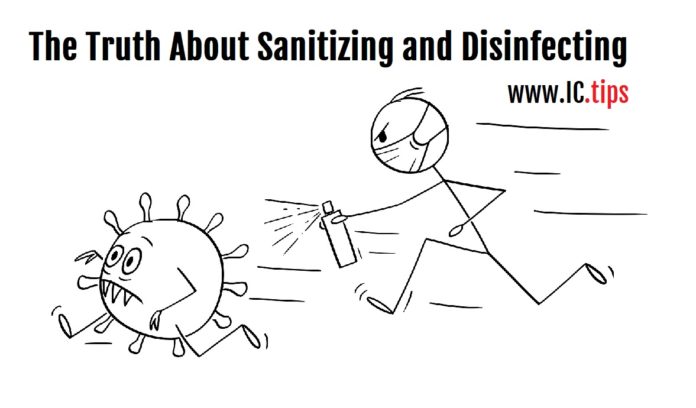Ever since the COVID-19 pandemic made its horrific debut, we have all seen some rendition of this scenario: airplane personnel scurrying down the aisles between flights, towel and disinfectant in hand, furiously wiping arm rests, headrests, and tray tables while the commentator assures the viewing public that the plane is being thoroughly “sanitized” between flights. The problem is, it is not really being sanitized, and if it were, it would do little to fight SARS-CoV-2, the virus behind COVID-19.
Since the COVID-19 pandemic pushed disinfection to the forefront on the world stage, sanitizing has taken on a new, technically improper meaning, one that brings with it potential safety risks.
Sanitize vs. Disinfect
To identify the problem, we need to have a clear understanding of the difference between what it means to sanitize or disinfect a surface.
A cleaning sanitizer—not to be confused with a hand sanitizer—is a formula that reduces (not kills) specific bacteria by 99.9% in the EPA-mandated 30 seconds or less timeframe. It is used in food service, restrooms, and other fast-turnover areas where pathogens must be reduced to a level deemed safe by the EPA in a short period of time to best protect the public. Sanitizers are effective in reducing the number of many types of pathogens (only those listed on the product’s label), but they have no impact on viruses.
Disinfectants kill (not reduce) up to 99.999% of specific pathogens, both bacteria and viruses. However, to disinfect, these formulas require “dwell time,” which entails keeping the surface wet with the disinfectant before wiping, usually for between 3 and 10 minutes. Without this time, the surface will not be disinfected.
There is no one disinfectant that kills all viruses. If the disinfectant in hand is not approved by the EPA to be effective against the virus being targeted, it is useless against that virus. In the United States, all disinfectants must be tested and approved by the EPA and can only list on the label those pathogens against which the formula has been scientifically proven to be effective.
When people are seen spraying disinfectant and wiping it off immediately and stating they are “sanitizing,” they are not
When people are seen spraying disinfectant and wiping it off immediately (in airplanes, and on grocery carts, electronics, counters, etc.) and stating they are “sanitizing,” they are not. What they are really doing, often unknowingly, is attempting to disinfect, but failing to leave the product on the surface long to be effective.
This is potentially dangerous, as it can create a false sense of security in those using the area that they are protected against viruses, such as SARS-CoV-2.
A Clean Start
Disinfectant dwell time aside, there is another problem with the ”spray, wipe, and go” method, and that is that disinfecting should never be a one-step process; before disinfecting can be done properly and effectively, the surface must be cleaned.
Cleaning alone can remove up to 90% of dirt and debris from a surface. More importantly, without cleaning, dirt and debris can shelter bacteria, viruses, and other pathogens, providing them with a safe harbor to live and even multiply.
Another problem with disinfecting without cleaning first is the disinfectant can build up, creating a biofilm in which these types of microscopic biological enemies can thrive.
Even when relying on a product that is disinfectant and cleaner in one, there needs to be a two-step process where the solution is applied first to clean using some form of agitation (sponge, rubbing, or water flow, for example), then re-applied and allowed its indicated dwell time to disinfect before a final wipe.
The Role of Cleaning Professionals
Doctors do not expect their patients to know how to perform surgeries, and car mechanics understand that most customers do not have a clue how fuel injection works, nor the difference between an axle and a piston; patients and customers expect these experts to do their jobs using the best practices of the profession. Likewise, cleaning professionals must fully understand the correct terms, processes, and procedures of the trade and how to employ them so that surfaces are clean and safe for the general public. Part of this mission should be to educate clients and expose those in the industry that knowingly deceive by using inaccurate terms or making false claims.
The spotlight is on the cleaning industry’s vital role in creating safe and healthy environments now more than ever before. Using accurate terms, correcting misconceptions, and advocating for proper methods will allow the industry and its professionals to shine ever brighter.
Updated: Feb 26, 2021












